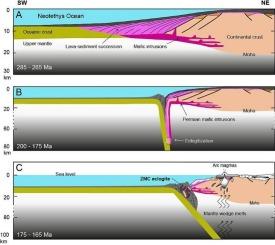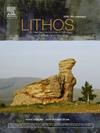伊朗西南部侏罗纪闪长岩和蚀变岩的二叠纪洪积玄武岩原岩:富含岩浆的被动边缘俯冲的影响
IF 2.9
2区 地球科学
Q2 GEOCHEMISTRY & GEOPHYSICS
引用次数: 0
摘要
富含岩浆的被动边缘以岩浆侵入体和熔岩为特征,使其密度与邻近的大洋地壳相当。因此,当俯冲开始时,这些边缘可能与大洋地壳一起下沉。这种可能性值得在地质记录中进一步研究。伊朗新特提安扎格罗斯缝合线以北的萨南达吉-锡尔詹区(Sanandaj-Sirjan Zone,SaSZ)就是一个很好的例子,那里的闪长岩至闪长岩成因的偏闪长岩出露于 Zayanderud 高压变质复合体中。我们介绍了 UPb 锆石年龄、全岩元素分析和 Sr-Nd-Hf 同位素数据,以确定变质岩原岩的年龄、化学和同位素组成以及构造环境。对岩相薄片进行的离子微探针 UPb 锆石地质年代学研究显示了二叠纪早中期原岩的年龄,这些锆石晶体很小(直径≤10 μm),在蚀变岩中被变质过度生长。蚀变岩和闪长岩的元素和 Sr-Nd-Hf 同位素组成表明它们与大陆洪积玄武岩有亲缘关系。痕量元素和同位素特征与潘加大陆解体和新特提斯洋开辟期间广泛喷发的二叠纪洪积玄武岩十分相似,阿曼、喜马拉雅山以及塔里木、天山和峨眉山亚洲大火成岩省都有很好的研究实例。早期的研究表明,蜕变发生在侏罗纪早中期。我们的研究结果支持这样一种假设,即在二叠纪建立了一个富含岩浆的被动边缘,随后在侏罗纪俯冲开始时沿着新特提斯山脉的这一地段沉入地幔。这一研究实例表明,在俯冲开始时,富含岩浆的被动边缘会发生深沉,而这一可能性尚未得到充分探讨。本文章由计算机程序翻译,如有差异,请以英文原文为准。

Permian flood basalt protoliths for Jurassic amphibolites and eclogites in SW Iran: Implications for subduction of a magma-rich passive margin
Magma-rich passive margins are characterized by mafic intrusions and lavas, making their density comparable to that of the adjoining oceanic crust. As a result, these margins may sink along with the oceanic crust when subduction begins. This possibility warrants further investigation in the geologic record. A fitting example can be found in the Sanandaj-Sirjan Zone (SaSZ), north of the Neotethyan Zagros suture in Iran, where amphibolite to eclogite-facies metabasites are exposed in the Zayanderud high-pressure metamorphic complex. We present U![]() Pb zircon ages, whole rock elemental analyses, and Sr-Nd-Hf isotope data to constrain the ages, chemical and isotopic composition, as well as the tectonic setting of the metabasite protoliths. Ion microprobe U
Pb zircon ages, whole rock elemental analyses, and Sr-Nd-Hf isotope data to constrain the ages, chemical and isotopic composition, as well as the tectonic setting of the metabasite protoliths. Ion microprobe U![]() Pb zircon geochronology on petrographic thin sections reveals Early–Middle Permian protolith ages for small (≤10 μm in diameter) zircon crystals that have been metamorphically overgrown in the eclogite. The elemental and Sr-Nd-Hf isotopic compositions of eclogites and amphibolites indicate a continental flood basalt affinity. Trace element and isotopic signatures closely resemble those of widespread Permian flood basalts erupted during breakup of Pangea and the opening of the Neotethys Ocean, with well-studied examples from Oman, the Himalayas, and the Asian Large Igneous Provinces in Tarim, Tianshan, and Emeishan. Earlier investigations suggested that the eclogitization occurred in the Early–Middle Jurassic. Our findings support a scenario where a magma-rich passive margin was established during the Permian and subsequently sank into the mantle at the onset of Jurassic subduction along this segment of the Neotethys. This studied example advocates a poorly explored possibility of the deep sinking of magma-rich passive margins at the beginning of subduction.
Pb zircon geochronology on petrographic thin sections reveals Early–Middle Permian protolith ages for small (≤10 μm in diameter) zircon crystals that have been metamorphically overgrown in the eclogite. The elemental and Sr-Nd-Hf isotopic compositions of eclogites and amphibolites indicate a continental flood basalt affinity. Trace element and isotopic signatures closely resemble those of widespread Permian flood basalts erupted during breakup of Pangea and the opening of the Neotethys Ocean, with well-studied examples from Oman, the Himalayas, and the Asian Large Igneous Provinces in Tarim, Tianshan, and Emeishan. Earlier investigations suggested that the eclogitization occurred in the Early–Middle Jurassic. Our findings support a scenario where a magma-rich passive margin was established during the Permian and subsequently sank into the mantle at the onset of Jurassic subduction along this segment of the Neotethys. This studied example advocates a poorly explored possibility of the deep sinking of magma-rich passive margins at the beginning of subduction.
求助全文
通过发布文献求助,成功后即可免费获取论文全文。
去求助
来源期刊

Lithos
地学-地球化学与地球物理
CiteScore
6.80
自引率
11.40%
发文量
286
审稿时长
3.5 months
期刊介绍:
Lithos publishes original research papers on the petrology, geochemistry and petrogenesis of igneous and metamorphic rocks. Papers on mineralogy/mineral physics related to petrology and petrogenetic problems are also welcomed.
 求助内容:
求助内容: 应助结果提醒方式:
应助结果提醒方式:


